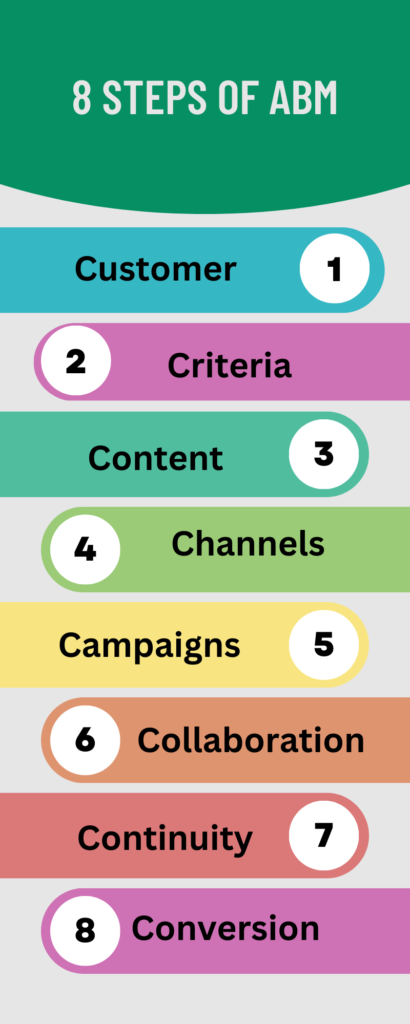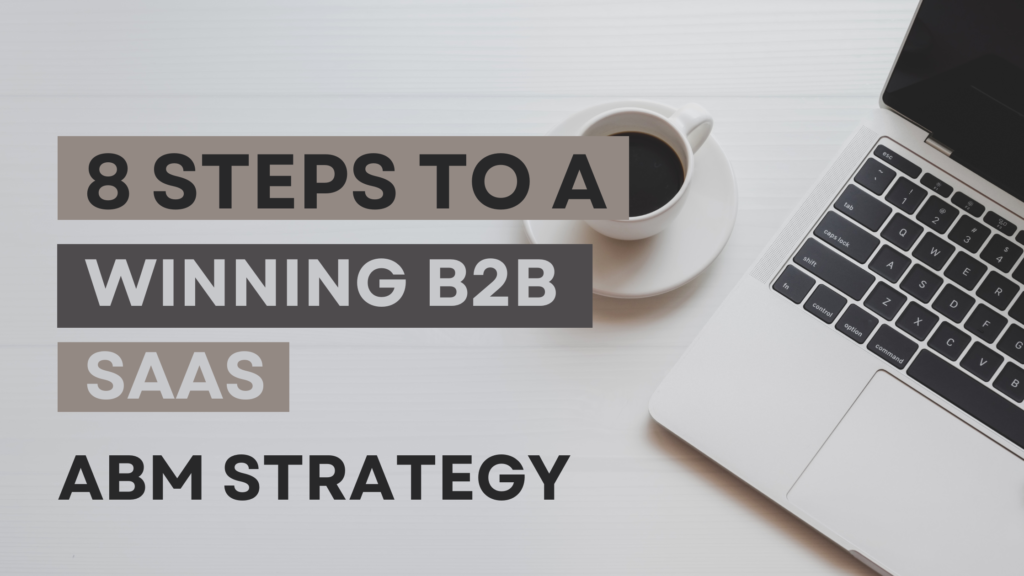The realm of B2B SaaS marketing is highly dynamic, and businesses must consistently explore novel avenues to connect with and engage their intended audience. Among the methods that have emerged as a top choice in recent years is Account-Based Marketing (ABM), which concentrates on tailoring marketing endeavors to specific high-value accounts.
Nevertheless, developing an ABM approach that is effective calls for methodical planning and meticulous execution. Within this blog post, we will outline the eight key steps required to construct a successful B2B SaaS ABM strategy, starting with the identification of your target accounts and culminating with the measurement of your outcomes.
Whether you are new to ABM or seeking to enhance your existing strategy, the recommendations we provide here will aid you in realizing better outcomes and accomplishing your business objectives.
What is ABM
“ABM” is an acronym that stands for “Account-Based Marketing”. It is a strategic approach to B2B marketing that centers around targeting specific accounts, typically high-value accounts, with personalized marketing efforts. ABM aims to develop a more precise and focused approach to marketing, in contrast to traditional methods that cast a wider net across the target market. ABM involves identifying and prioritizing accounts that are most likely to result in significant business growth and revenue and then tailoring marketing strategies and tactics to the specific needs and preferences of those accounts. ABM has gained popularity in recent years as a more effective way to generate high-quality leads and secure valuable accounts for B2B companies.
How is ABM different from outbound or inbound marketing?
Account-Based Marketing (ABM) is an approach to B2B marketing that differs from traditional outbound and inbound marketing methods. While outbound marketing casts a wider net and targets a broader audience in the hopes of generating leads, inbound marketing draws potential leads to the company’s website through educational or informative content. In contrast, ABM is a highly targeted approach that focuses on a select group of high-value accounts and creates personalized marketing strategies for them.
Unlike outbound marketing, which often relies on email campaigns or mass advertising to reach a wide audience, ABM targets a select group of key decision-makers within specific accounts. By customizing marketing messages to resonate with each account’s unique needs and interests, ABM can build more personal relationships with customers and drive higher conversion rates.
Similarly, inbound marketing often relies on content marketing to draw in potential leads through informative blogs, e-books, or webinars. ABM, however, takes a more personalized approach by creating content that is specifically tailored to the interests and needs of each target account. This helps to build trust and foster long-term relationships with key accounts.
Ultimately, ABM differs from traditional inbound and outbound marketing approaches by focusing on quality over quantity. Rather than targeting a broad audience or waiting for leads to come to them, ABM prioritizes the most valuable accounts and creates highly personalized marketing strategies to engage them. By building relationships with high-value accounts, ABM can help B2B companies achieve more significant revenue growth and drive better business outcomes.
Related Post: Maximizing ROI in B2B Marketing: Tips and Techniques
The 8 Steps of ABM
Account-Based Marketing (ABM) is a strategic approach to B2B marketing that focuses on targeting high-value accounts and creating personalized marketing strategies for them. While ABM has gained significant traction in recent years, developing an effective ABM strategy requires a thoughtful and structured approach. The 8 C’s of ABM provide a helpful framework for B2B companies to develop a successful ABM strategy.

Customer
The first step in an ABM strategy is to identify your target customers or accounts. By defining your ideal customer profile and identifying the key decision-makers within each account, you can create more personalized marketing messages that resonate with their unique needs and interests. Start by considering the pain points that your ideal customer is experiencing and how your product or service can help alleviate those challenges.
Criteria
Once you’ve identified your target accounts, the next step is to define the criteria that qualify an account as high-value. This can include factors like revenue potential, industry, and company size. By prioritizing high-value accounts, you can focus your resources on the accounts that are most likely to drive significant revenue growth.
Content
Developing personalized content for each account is a critical aspect of ABM. By creating content that is tailored to each account’s specific pain points and interests, you can build more personal relationships with customers and drive higher conversion rates. This can include case studies, white papers, or other relevant materials that address the specific challenges of each account.
Channels
Once you’ve developed targeted content for each account, the next step is to determine the most effective channels for reaching your target accounts. This could include email, social media, or personalized landing pages. By selecting the right channels, you can ensure that your marketing messages are reaching the right people at the right time.
Campaigns
Developing targeted campaigns for each account is another critical aspect of ABM. These campaigns should be personalized to the specific needs and interests of each account. By tailoring your marketing messages to the unique challenges of each account, you can build more personal relationships with customers and drive higher conversion rates.
Collaboration
Effective ABM requires close collaboration between sales and marketing teams. Sales teams can provide valuable insights into each account’s unique challenges and pain points, which can help marketing teams develop more effective personalized messaging. By working together, sales and marketing teams can ensure that their ABM efforts are aligned and focused on the most high-value accounts.
Continuity
Maintaining consistent engagement with each account is critical for long-term success in ABM. This includes ongoing communication, relationship building, and tracking their progress through the sales funnel. By maintaining a consistent presence with each account, you can build trust and foster long-term relationships that drive significant revenue growth over time.
Conversion
Measuring the success of your ABM efforts is critical for refining your strategy and optimizing your marketing efforts over time. By tracking conversion rates and other key metrics, you can determine which aspects of your ABM strategy are working and which need to be refined. This will help you continue to improve and optimize your ABM strategy over time, driving better business outcomes.
By following the 8 C’s of ABM, B2B companies can develop a comprehensive and effective ABM strategy that targets high-value accounts and drives significant revenue growth over time.
Get in touch with Gignaut – a B2B SaaS Marketing Agency today to start measuring and improving your marketing efforts.
Check the B2B SaaS Marketing Handbook to learn more.
Also, check the top content marketing agencies
Uzma is a Professional Content Writer and Certified Digital Marketing Expert




